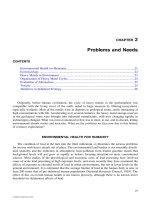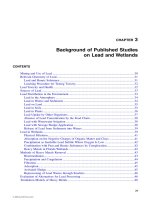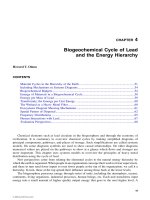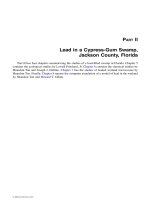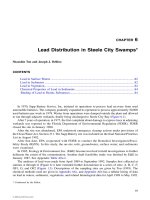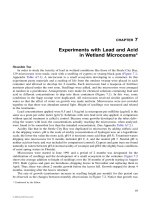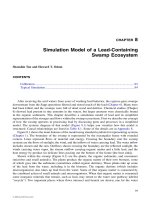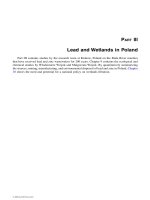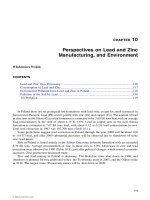Heavy metals in the environment
Bạn đang xem bản rút gọn của tài liệu. Xem và tải ngay bản đầy đủ của tài liệu tại đây (36.65 MB, 493 trang )
Tai Lieu Chat Luong
HEAVY METALS
IN THE
ENVIRONMENT
2009 by Taylor & Francis Group, LLC
168_C000.indd i
5/21/2009 6:18:14 PM
ADVANCES IN INDUSTRIAL AND HAZARDOUS
WASTES TREATMENT SERIES
Advances in Hazardous Industrial Waste Treatment (2009)
edited by Lawrence K. Wang, Nazih K. Shammas, and Yung-Tse Hung
Waste Treatment in the Metal Manufacturing, Forming, Coating,
and Finishing Industries (2009)
edited by Lawrence K. Wang, Nazih K. Shammas, and Yung-Tse Hung
Heavy Metals in the Environment (2009)
edited by Lawrence K. Wang, J. Paul Chen, Nazih K. Shammas,
and Yung-Tse Hung
Handbook of Industrial and Hazardous Wastes Treatment, Volume II (2010)
edited by Lawrence K. Wang, Yung-Tse Hung, and Nazih K. Shammas
RELATED TITLES
Handbook of Industrial and Hazardous Wastes Treatment (2004)
edited by Lawrence K. Wang, Yung-Tse Hung, Howard H. Lo,
and Constantine Yapijakis
Waste Treatment in the Food Processing Industry (2006)
edited by Lawrence K. Wang, Yung-Tse Hung, Howard H. Lo,
and Constantine Yapijakis
Waste Treatment in the Process Industries (2006)
edited by Lawrence K. Wang, Yung-Tse Hung, Howard H. Lo,
and Constantine Yapijakis
Hazardous Industrial Waste Treatment (2007)
edited by Lawrence K. Wang, Yung-Tse Hung, Howard H. Lo,
and Constantine Yapijakis
2009 by Taylor & Francis Group, LLC
168_C000.indd ii
5/21/2009 6:18:14 PM
2009 by Taylor & Francis Group, LLC
168_C000.indd iii
5/21/2009 6:18:15 PM
2009 by Taylor & Francis Group, LLC
168_C000.indd iv
5/21/2009 6:18:15 PM
Contents
Preface ......................................................................................................................................... vii
Editors .......................................................................................................................................... ix
Contributors ................................................................................................................................ xi
Chapter 1
Metal Research Trends in the Environmental Field ................................................. 1
Yuh-Shan Ho and Mohammad I. El-Khaiary
Chapter 2
Toxicity and Sources of Pb, Cd, Hg, Cr, As, and Radionuclides
in the Environment ................................................................................................. 13
Ghinwa M. Naja and Bohumil Volesky
Chapter 3
Environmental Behavior and Effects of Engineered Metal
and Metal Oxide Nanoparticles .............................................................................. 63
Bernd Nowack
Chapter 4
Heavy Metal Removal with Exopolysaccharide-Producing Cyanobacteria .......... 89
Roberto De Philippis and Ernesto Micheletti
Chapter 5
Environmental Geochemistry of High-Arsenic Aquifer Systems ....................... 123
Yanxin Wang and Yamin Deng
Chapter 6
Nanotechnology Application in Metal Ion Adsorption ........................................ 155
Xiangke Wang and Changlun Chen
Chapter 7
Biosorption of Metals onto Granular Sludge ....................................................... 201
Shu Guang Wang, Xue Fei Sun, Wen Xin Gong, and Yue Ma
Chapter 8
Arsenic Pollution: Occurrence, Distribution, and Technologies .......................... 225
Huijuan Liu, Ruiping Liu, Jiuhui Qu, and Gaosheng Zhang
Chapter 9
Treatment of Metal-Bearing Effluents: Removal and Recovery .......................... 247
Ghinwa M. Naja and Bohumil Volesky
v
2009 by Taylor & Francis Group, LLC
168_C000.indd v
5/21/2009 6:18:15 PM
vi
Contents
Chapter 10 Management and Treatment of Acid Pickling Wastes Containing
Heavy Metals ........................................................................................................ 293
Lawrence K. Wang, Veysel Eroglu, and Ferruh Erturk
Chapter 11 Treatment and Management of Metal Finishing Industry Wastes ....................... 315
Nazih K. Shammas and Lawrence K. Wang
Chapter 12 Recycling and Disposal of Hazardous Solid Wastes Containing Heavy
Metals and Other Toxic Substances ..................................................................... 361
Lawrence K. Wang
Chapter 13 Management and Removal of Heavy Metals from Contaminated Soil ............... 381
Nazih K. Shammas
Chapter 14 Remediation of Metal Finishing Brownfield Sites ............................................... 431
Nazih K. Shammas
Chapter 15 Control, Management, and Treatment of Metal Emissions from
Motor Vehicles ..................................................................................................... 475
Rajasekhar Balasubramanian, Jun He, and Lawrence K. Wang
2009 by Taylor & Francis Group, LLC
168_C000.indd vi
5/21/2009 6:18:15 PM
Preface
Environmental managers, engineers, and scientists who have had experience with industrial and
hazardous waste management problems have noted the need for a handbook series that is comprehensive in its scope, directly applicable to daily waste management problems of specific industries,
and widely acceptable by practicing environmental professionals and educators. Taylor & Francis
and CRC Press have developed this timely book series entitled Advances in Industrial and
Hazardous Wastes Treatment, which emphasizes in-depth presentation of environmental pollution
sources, waste characteristics, control technologies, management strategies, facility innovations,
process alternatives, costs, case histories, effluent standards, and future trends for each industrial or
commercial operation, and in-depth presentation of methodologies, technologies, alternatives,
regional effects, and global effects of each important industrial pollution control practice that may
be applied to all industries.
Heavy Metals in the Environment is the third book in the Advances in Industrial and Hazardous
Wastes Treatment series. The importance of metals, such as lead, chromium, cadmium, zinc, copper, nickel, iron, and mercury, is discussed in detail. They could be important constituents of most
living animals, plants, and microorganisms, and many nonliving substances in the environment.
Some of them are essential for growth of biological and microbiological lives. Their absence could
limit growth of small microorganisms to large plants or animals. However, the presence of any of
these heavy metals in excessive quantities will be harmful to human beings, and will interfere with
many beneficial uses of the environment due to their toxicity and mobility. Therefore, it is frequently desirable to measure and control the heavy metal concentrations in the environment.
In a deliberate effort to complement other industrial waste treatment and hazardous waste
management texts published by Taylor & Francis and CRC Press, this book, Heavy Metals in the
Environment, covers the important results in research of metals in environment. In the first two
chapters, the recent research trends and the toxicity and sources of heavy metals are covered. The
processes and mechanisms on metals in the environment are covered in Chapters 3–7; they are the
environmental behavior and effects of engineered metal and metal oxide nanoparticles, environmental geochemistry of high arsenic aquifer systems, nanotechnology application in metal ion
adsorption, biosorption of metals, and heavy metal removal by exopolysaccharide-producing
cyanobacteria. In Chapters 8–14, technologies for metal treatment and management are addressed.
These cover technologies for metal bearing effluents, metal contained solid wastes, metal finishing
industry wastes, metal finishing brownfield sites, and arsenic contaminated groundwater streams.
Metal in the atmosphere can greatly affect health of human beings. Chapter 15 addresses control,
treatment, and management of metal emissions from motor vehicles.
Special efforts were made to invite experts to contribute chapters in their own areas of expertise.
Since the area of hazardous industrial waste treatment is very broad, no one can claim to be an
expert in all heavy metals and their related industries; collective contributions are better than a
single author’s presentation for a book of this nature.
This book, Heavy Metals in the Environment, is to be used as a college textbook as well as a
reference book for the environmental professional. It features the major hazardous heavy metals in
air, water, land, and facilities that have significant effects on the public health and the environment.
Professors, students, and researchers in environmental, civil, chemical, sanitary, mechanical, and
public health engineering and science will find valuable educational materials here. The extensive
vii
2009 by Taylor & Francis Group, LLC
168_C000.indd vii
5/21/2009 6:18:15 PM
viii
Preface
bibliographies for each heavy metal or metal-related industrial waste treatment or practice should
be invaluable to environmental managers or researchers who need to trace, follow, duplicate, or
improve on a specific industrial hazardous waste treatment practice.
A successful modern heavy metal control program for a particular industry will include not only
traditional water pollution control but also air pollution control, soil conservation, site remediation,
groundwater protection, public health management, solid waste disposal, and combined industrial–
municipal heavy metal waste management. In fact, it should be a total environmental control program. Another intention of this handbook is to provide technical and economical information on the
development of the most feasible total heavy metal control program that can benefit both industry
and local municipalities. Frequently, the most economically feasible methodology is a combined
industrial–municipal heavy metal management.
Lawrence K. Wang, New York
Jiaping Paul Chen, Singapore
Yung-Tse Hung, Ohio
Nazih K. Shammas, Massachusetts
2009 by Taylor & Francis Group, LLC
168_C000.indd viii
5/21/2009 6:18:15 PM
Editors
Lawrence K. Wang has over 25 years of experience in facility design, plant construction, operation,
and management. He has expertise in water supply, air pollution control, solid waste disposal, water
resources, waste treatment, hazardous waste management, and site remediation. He is a retired
dean/director of both the Lenox Institute of Water Technology and Krofta Engineering Corporation, Lenox, Massachusetts, and a retired vice president of Zorex Corporation, Newtonville,
New York. Dr. Wang is the author of over 700 technical papers and 19 books, and is credited with
24 U.S. patents and 5 foreign patents. He received his BSCE degree from the National Cheng-Kung
University, Taiwan, his MS degrees from both the Missouri University of Science and Technology
and the University of Rhode Island and his PhD degree from Rutgers University, New Jersey.
Jiaping Paul Chen is an associate professor of environmental science and engineering at the
National University of Singapore. His research interests are physicochemical treatment of water and
wastewater and modeling. He has published more than 80 journal papers and book chapters. He has
received various honors and awards, including Guest Professor of the Hua Zhong University of
Science and Technology, and Shandong University of China, and Distinguished Overseas Chinese
Young Scholar of National Natural Science Foundation of China. He is recognized as an author of
highly cited papers (chemistry and engineering) of ISI Web of Knowledge. Professor Chen received
his ME degree from the Tsinghua University, Beijing and his PhD degree from the Georgia Institute
of Technology of Atlanta, Georgia.
Yung-Tse Hung has been a professor of civil engineering at Cleveland State University since 1981.
He is a Fellow of the American Society of Civil Engineers. He has taught at 16 universities in eight
countries. His primary research interests and publications have been involved with biological wastewater treatment, industrial water pollution control, industrial waste treatment, and municipal wastewater treatment. He is now credited with over 450 publications and presentations on water and
wastewater treatment. Dr. Hung received his BSCE and MSCE degrees from the National ChengKung University, Taiwan, and his PhD degree from the University of Texas at Austin. He is the
editor of International Journal of Environment and Waste Management, International Journal of
Environmental Engineering, and International Journal of Environmental Engineering Science.
Nazih K. Shammas has been an environmental expert, professor, and consultant for over
40 years. He is an ex-dean and director of the Lenox Institute of Water Technology, and advisor to
Krofta Engineering Corporation, Lenox, Massachusetts. Dr. Shammas is the author of over 250
publications and eight books in the field of environmental engineering. He has experience in environmental planning, curriculum development, teaching and scholarly research, and expertise in
water quality control, wastewater reclamation and reuse, physicochemical and biological treatment
processes, and water and wastewater systems. He received his BE degree from the American
University of Beirut, Lebanon, his MS from the University of North Carolina at Chapel Hill, and his
PhD from the University of Michigan at Ann Arbor.
ix
2009 by Taylor & Francis Group, LLC
168_C000.indd ix
5/21/2009 6:18:15 PM
Contributors
Rajasekhar Balasubramanian
Division of Environmental Science and
Engineering
National University of Singapore
Singapore
Jun He
Division of Environmental Engineering
and Science
National University of Singapore
Singapore
Changlun Chen
Institute of Plasma Physics
Chinese Academy of Science
Beijing, China
Yuh-Shan Ho
Department of Environmental
Sciences
Peking University
Beijing, China
Yamin Deng
School of Environmental Studies and
MOE Key Laboratory of Biogeology
and Environmental Geology
China University of Geosciences
Wuhan, China
Roberto De Philippis
Department of Agricultural Biotechnology
University of Florence
Florence, Italy
Mohammad I. El-Khaiary
Chemical Engineering Department
Alexandria University
Alexandria, Egypt
Veysel Eroglu
Minister of Environment and Forestry
Istanbul Technical University
Istanbul, Turkey
Huijuan Liu
Research Center for Eco-Environmental
Sciences
Chinese Academy of Sciences
Beijing, China
Ruiping Liu
Research Center for Eco-Environmental
Sciences
Chinese Academy of Sciences
Beijing, China
Yue Ma
School of Environmental Science and
Engineering
Shandong University
Shandong, China
Ferruh Erturk
Yıldız Technical University
Istanbul, Turkey
Ernesto Micheletti
Department of Agricultural
Biotechnology
University of Florence
Florence, Italy
Wen Xin Gong
School of Environmental Science and
Engineering
Shandong University
Shandong, China
Ghinwa M. Naja
Department of Chemical
Engineering
McGill University
Montreal, Quebec, Canada
xi
2009 by Taylor & Francis Group, LLC
168_C000.indd xi
5/21/2009 6:18:15 PM
xii
Bernd Nowack
Materials, Products and the
Environment Group
Swiss Federal Laboratories for Materials
Testing and Research
St. Gallen, Switzerland
Jiuhui Qu
Research Center for Eco-Environmental
Sciences
Chinese Academy of Sciences
Beijing, China
Nazih K. Shammas
Lenox Institute of Water Technology
Krofta Engineering Corporation
Lenox, Massachusetts
Xue Fei Sun
School of Environmental Science
and Engineering
Shandong University
Shandong, China
Bohumil Volesky
Department of Chemical Engineering
McGill University
Montreal, Quebec, Canada
Contributors
Laurence K. Wang
Krofta Engineering Corporation
Zorex Corporation
Lenox Institute of Water Technology
Lenox, Massachusetts
Shu Guang Wang
School of Environmental Science
and Engineering
Shandong University
Shandong, China
Xiangke Wang
Institute of Plasma Physics
Chinese Academy of Science
Beijing, China
Yanxin Wang
School of Environmental Studies and
MOE Key Laboratory of Biogeology
and Environmental Geology
China University of Geosciences
Wuhan, China
Gaosheng Zhang
Yantai Institute of Coastal Zone Research
for Sustainable Development
Chinese Academy of Sciences
Shandong, China
2009 by Taylor & Francis Group, LLC
168_C000.indd xii
5/21/2009 6:18:15 PM
Research Trends in the
1 Metal
Environmental Field
Yuh-Shan Ho and Mohammad I. El-Khaiary
CONTENTS
1.1
1.2
1.3
Introduction ........................................................................................................................ 1
Data Sources and Methodology .......................................................................................... 2
Results and Discussion ....................................................................................................... 2
1.3.1 Language of Publication ......................................................................................... 2
1.3.2 Article Output and Distribution in Journals ........................................................... 3
1.3.3 Publication Performance: Countries, Institutes, and Authorship ........................... 3
1.3.4 Research Emphasis: Author Keywords and Keywords Plus ................................... 8
1.4 Conclusions ......................................................................................................................... 10
References .................................................................................................................................... 11
1.1 INTRODUCTION
It has long been known that, in the right concentrations, many metals are essential to life and ecosystems [1–4]; chronic low exposures to metals can lead to severe environmental and health effects.
Similarly, in excess, these same metals can be poisonous [5–9]. The main metal threats are associated with heavy metals such as lead, arsenic, cadmium, and mercury. Unlike many organic pollutants, which eventually degrade to carbon dioxide and water, heavy metals will tend to accumulate
in the environment, especially in lake, estuarine, or marine sediments [10]. Metals can also be transported from one environment compartment to another [11], which complicates the containment
and treatment problem.
Heavy metals are closely connected with environmental deterioration and the quality of human
life, and thus have aroused concern all over the world. More and more countries have signed treaties
to monitor and reduce heavy metal pollution [12]. Moreover, this field of research has been receiving
increasing scientific attention due to its negative effects on life [9,10,13,14]; it was found that metals
accumulate in animal and plant cells, leading to severe negative effects. The transport and accumulation of heavy metals by air [15], water [14,16], and soil [17,18] have also been a hot topic for
research. It was found that in some cases contamination was circulated on a global range. Another
related research topic was the monitoring of metal pollution and predicting critical levels and loads,
which distilled into national and international regulations such as the European Union’s Dangerous
Substances Directive [19], the U.S. EPA [20] for water, the EU Air Quality Framework Directive
[21], and the World Health Organization [22] for air.
A large body of research that deals with the treatment of metal pollution by different methods
such as adsorption [23–26], activated sludge [27,28], phytoextraction [29–32], electrokinetic methods [33], electroosmosis [34], and ion exchange [35] has also been published.
1
2009 by Taylor & Francis Group, LLC
168_C001.indd 1
5/20/2009 7:34:10 PM
2
Heavy Metals in the Environment
Today, researchers are carrying out more comprehensive studies on metal pollution, leading to
the unusual breadth of topics. Despite increasing interest, there have been few attempts at gathering
systematic data on the nature and extent of metal pollution research. Garfield indicated that recent
research focus could be detected by publication output [36]. A common research tool is the bibliometric method, which has already been widely applied to many fields of science and engineering.
Furthermore, the Science Citation Index (SCI), from the Institute for Scientific Information (ISI),
Web of Science databases, is the most important and frequently used source database of choice for
a broad review of scientific accomplishment [37–39].
1.2 DATA SOURCES AND METHODOLOGY
Data were based on the online version of the SCI, Web of Science. SCI is a multidisciplinary database of the ISI, Philadelphia, USA. According to Journal Citation Reports (JCR), it indexes 6166
major journals with citation references across 172 scientific disciplines in 2006. One hundred and
ninety-five journals listed in the three ISI subject categories of environmental engineering (n = 35),
environmental sciences (n = 144), and water resources (n = 57) were considered in this study. The
online version of SCI was searched under the keyword “metal or metals” to compile a bibliography
of all papers related to metal research from 1991 to 2006. Articles originating from England,
Scotland, Northern Ireland, and Wales were reclassified as being from the United Kingdom.
Besides, the reported impact factor (IF) of each journal was obtained from the 2006 JCR.
Collaboration type was determined by the addresses of the authors, where the term “single
country” was assigned if the researchers’ addresses were from the same country. The term “international collaboration” was assigned to those articles that were coauthored by researchers from
multiple countries.
1.3 RESULTS AND DISCUSSION
The total number of publications that met the selection criteria was 25,449. These publications were
divided into 13 document types. The most frequently used document type (96%) was articles
(24,409), followed distantly by reviews (609; 2.39%). Other document types of less significance
were notes (108; 0.42%), letters (108; 0.42%), and editorial material (104; 0.41%). Since peer-reviewed
journal articles represent the majority of documents within this field, 24,409 articles were further
analyzed in this study. The emphasis of the following discussion is to determine the pattern of scientific production; research activity trends that consist of authorship, institutes, and countries; and
also the trends in the research subjects addressed.
1.3.1
LANGUAGE OF PUBLICATION
Written languages of all metal-related articles in the environmental field were grouped. The results
showed that English had a clear monopoly, making up 99% of all article publications. Other languages were French (0.26%), German (0.25%), and Spanish (0.025%). French articles were published in Environmental Technology (n = 32), Houille Blanche-Revue Internationale de l Eau
(n = 14), Water Quality Research Journal of Canada (n = 8), Journal of Environmental Engineering
and Science (n = 6), Water Research (n = 3), and Science of the Total Environment (n = 1). German
articles were published in Gefahrstoffe Reinhaltung der Luft (n = 34), Acta Hydrochimica et
Hydrobiologica (n = 27), and Isotopes in Environmental and Health Studies (n = 1). Only one journal published Spanish articles: Ingenieria Hidraulica en Mexico (n = 6). For all practical purposes,
English was the international language of choice in metal research, at least according to the SCI
database. We leave the debate of whether or not English was the lingua franca of international scientific communication to other commentators [40].
2009 by Taylor & Francis Group, LLC
168_C001.indd 2
5/20/2009 7:34:10 PM
3
Metal Research Trends in the Environmental Field
1.3.2
ARTICLE OUTPUT AND DISTRIBUTION IN JOURNALS
Figure 1.1 shows the article output results from 1991 to 2006. The number of articles per year
increased from 550 in 1991 to 2871 in 2006, reflecting the increasing interest in this field of research.
More than 55% of the records were published during the period 2001–2006. In total, 24,409 articles
were published in 173 journals. Six core journals contained 34% of the total articles. Figure 1.2
shows the trend of article publication in these six journals from 1991 to 2006. It is noticed that
Applied Catalysis A—General rose from the sixth rank in 1991 to the first rank in 2006; also
Chemosphere rose from the fifth rank in 1991 to the second rank in 2006.
1.3.3
PUBLICATION PERFORMANCE: COUNTRIES, INSTITUTES, AND AUTHORSHIP
Among the 24,409 articles produced in 145 countries, the top 20 most active countries produced
23,062 articles (95%), whereas the remaining 125 countries produced 1347 articles. Table 1.1 shows
that the most active country was the United States (6081; 25%). The United States also produced the
most independent publications (4859; 24%). Moreover, the seven most industrialized countries (G7:
Canada, France, Germany, Italy, Japan, the United Kingdom, and the United States) collectively
held the major portion (59%) of the world’s publication. Figures 1.3 and 1.4 show the trend of article
production in the top 10 countries from 1991 to 2006. The numbers of articles produced per year seem
to increase at similar rates for most countries, except for China (whose rank changed from tenth in
1991 to second in 2006) and Spain (whose rank changed from ninth in 2001 to third in 2006).
The top 20 most productive institutes are listed in Table 1.2. There are seven institutes from the
United States, three from Canada, two from China, and one each from Spain, Italy, France, Taiwan,
3500
3000
2871
2454
2500
2354
Number of articles
2155
1926
2000
1777
1474 1459
1500
1205
1532
1269
1036 1020
1000
550
624
703
2006
2005
2004
2003
2002
2001
2000
1999
1998
1997
1996
1995
1994
1993
1992
0
1991
500
Year
FIGURE 1.1
Publication outputs per year for the period 1991–2006.
2009 by Taylor & Francis Group, LLC
168_C001.indd 3
5/20/2009 7:34:10 PM
4
Heavy Metals in the Environment
250
Applied Catalysis A-General
Environmental Science & Technology
Science of the Total Environment
200
Chemosphere
Environmental Pollution
Number of articles
Water Air and Soil Pollution
150
100
2007
2006
2005
2004
2003
2002
2001
2000
1999
1998
1997
1996
1995
1994
1993
1992
1991
0
1990
50
Year
FIGURE 1.2 Comparison of the growth trends of articles in the top six active journals during the period
1991–2006.
TABLE 1.1
Top 20 Most Productive Countries of Articles during 1991–2006
Country
United States
United Kingdom
Canada
France
Italy
Spain
Germany
India
China
Japan
Australia
Netherlands
Sweden
Turkey
Poland
Taiwan
Belgium
South Korea
Hong Kong
Finland
TP
%TP
SP
R (%
%)
CP
R (%
%)
FP
R (%
%)
RP
R (%
%)
6081
1809
1569
1298
1297
1263
1154
1109
1076
1010
647
638
634
574
568
546
498
454
434
403
25
7.4
6.4
5.3
5.3
5.2
4.7
4.6
4.4
4.1
2.7
2.6
2.6
2.4
2.3
2.2
2.0
1.9
1.8
1.7
4854
1140
1103
822
1042
939
682
950
642
730
432
417
429
516
399
480
288
293
252
281
1 (24)
2 (5.6)
3 (5.4)
7 (4.0)
4 (5.1)
6 (4.6)
9 (3.4)
5 (4.7)
10 (3.2)
8 (3.6)
13 (2.1)
15 (2.1)
14 (2.1)
11 (2.5)
16 (2.0)
12 (2.4)
19 (1.4)
18 (1.4)
22 (1.2)
20 (1.4)
1227
669
466
476
255
324
472
159
434
280
215
221
205
58
169
66
210
161
182
122
1 (30)
2 (17)
5 (12)
3 (12)
9 (6.3)
7 (8.0)
4 (12)
19 (4.0)
6 (11)
8 (7.0)
11 (5.3)
10 (5.5)
13 (5.1)
31 (1.4)
15 (4.2)
28 (1.6)
12 (5.2)
17 (4.0)
14 (4.5)
22 (3.0)
5448
1432
1353
1037
1159
1101
881
1035
861
853
528
505
527
549
499
510
380
367
367
340
1 (22.4)
2 (5.9)
3 (5.6)
6 (4.3)
4 (4.8)
5 (4.5)
8 (3.6)
7 (4.2)
9 (3.5)
10 (3.5)
12 (2.2)
15 (2.1)
13 (2.2)
11 (2.3)
16 (2.0)
14 (2.1)
17 (1.6)
18 (1.5)
18 (1.5)
20 (1.4)
4925
1285
1212
941
1126
1038
828
945
826
795
501
445
496
536
492
491
369
359
350
328
1 (22)
2 (5.7)
3 (5.3)
7 (4.1)
4 (5.0)
5 (4.6)
8 (3.6)
6 (4.2)
9 (3.6)
10 (3.5)
12 (2.2)
16 (2.0)
13 (2.2)
11 (2.4)
14 (2.2)
15 (2.2)
17 (1.6)
18 (1.6)
19 (1.5)
20 (1.4)
Notes: TP, total publications; SP, independent publication; CP, international collaborative publication; %TP, share in publication; R, ranking; FP, first author publication; and RP, corresponding author publication.
2009 by Taylor & Francis Group, LLC
168_C001.indd 4
5/20/2009 7:34:10 PM
5
Metal Research Trends in the Environmental Field
300
UK
Canada
250
France
Italy
Spain
Number of articles
200
Germany
India
China
150
Japan
100
2006
2005
2004
2003
2002
2001
2000
1999
1998
1997
1996
1995
1994
1993
1992
0
1991
50
Year
FIGURE 1.3 Comparison of the growth trends of articles in active countries (ranking as second to ninth)
during the period 1991–2006. Noted that United States is ranked as the first country and its growth trend is
given in Figure 1.4.
600
Articles
Corresponding author articles
500
Number of articles
400
300
200
2006
2005
2004
2003
2002
2001
2000
1999
1998
1997
1996
1995
1994
1993
1992
0
1991
100
Year
FIGURE 1.4
The growth trends of articles in the United States during the period 1991–2006.
2009 by Taylor & Francis Group, LLC
168_C001.indd 5
5/20/2009 7:34:10 PM
6
Heavy Metals in the Environment
TABLE 1.2
Top 20 Most Productive Institutes of Articles during 1991–2006
Institute
TP
TP R (%
%)
SP R (%
%)
CP R (%
%)
FP R (%
%)
RP R (%
%)
U.S. Environmental Protection Agency, USA
Chinese Academy of Sciences, China
Consejo Superior de Investigaciones
Científicas (CSIC), Spain
United States Geological Survey (USGS), USA
Consiglio Nazionale delle Ricerche (CNR), Italy
Environment Canada, Canada
University of Quebec, Canada
University of Florida, USA
University of Delaware, USA
Rutgers, The State University
of New Jersey, USA
University of Georgia, USA
Le Centre National de la Recherche
Scientifique (CNRS), France
McGill University, Canada
University of Maryland, USA
National Taiwan University, Taiwan
Hong Kong University of Science and
Technology, Hong Kong
Zhejiang University, China
Imperial College of Science, Technology
and Medicine, University of London, UK
Universiteit Gent, Belgium
Indian Institute of Technology, India
375
330
316
1 (1.5)
2 (1.4)
3 (1.3)
4 (0.7)
1 (0.99)
2 (0.96)
1 (2.5)
2 (1.8)
3 (1.7)
3 (0.85)
1 (0.99)
2 (0.91)
2 (1)
1 (1.0)
3 (0.9)
237
211
177
174
165
158
149
4 (0.97)
5 (0.87)
6 (0.73)
7 (0.71)
8 (0.68)
9 (0.65)
10 (0.61)
3 (0.76)
15 (0.4)
26 (0.31)
5 (0.62)
8 (0.46)
19 (0.37)
29 (0.30)
5 (1.2)
4 (1.4)
6 (1.2)
11 (0.82)
10 (0.93)
7 (0.97)
7 (0.97)
4 (0.64)
6 (0.53)
9 (0.46)
5 (0.55)
7 (0.47)
8 (0.46)
14 (0.38)
4 (0.72)
5 (0.57)
7 (0.45)
6 (0.45)
7 (0.45)
11 (0.41)
12 (0.41)
136
131
11 (0.56)
12 (0.54)
15 (0.40)
98 (0.16)
13 (0.74)
7 (0.97)
15 (0.36)
25 (0.29)
18 (0.32)
24 (0.28)
128
123
122
120
13 (0.53)
14 (0.50)
15 (0.50)
16 (0.49)
13 (0.41)
19 (0.37)
18 (0.39)
6 (0.60)
16 (0.65)
14 (0.66)
17 (0.63)
67 (0.37)
13 (0.39)
20 (0.32)
19 (0.34)
11 (0.41)
13 (0.38)
19 (0.31)
16 (0.33)
9 (0.43)
118
117
17 (0.48)
18 (0.48)
12 (0.42)
15 (0.40)
25 (0.56)
22 (0.57)
10 (0.41)
16 (0.35)
9 (0.43)
20 (0.30)
116
115
19 (0.48)
20 (0.47)
9 (0.44)
7 (0.56)
30 (0.52)
67 (0.37)
17 (0.34)
12 (0.40)
15 (0.37)
14 (0.37)
Notes: TP, total publications; SP, independent publication; CP, international collaborative publication; FP, first author
publication; RP, corresponding author publication; and R, ranking.
Hong Kong, the United Kingdom, Belgium, and India. The highest production came from the U.S.
EPA (375; 1.5%), followed closely by the Chinese Academy of Sciences (330; 1.4%) and CSIC
from Spain (316, 1.3%). The high activity of the latter two institutes is partially responsible for the
recent increase in rank of China and Spain.
Collaboration plays an important role in contemporary scientific research, which is manifested
in internationally coauthored papers traced by bibliometric tools [41]. Among the 24,365 articles
with author address published from 1991 to 2006, 13,080 (54%) were produced by single institutions, whereas 7304 (30%) were produced by intranational collaboration and 4025 (17%) by international collaboration (CP). The United States produced the largest number of CP (1227), which amounts
to 20% of the total articles from the United States and 30% of CP produced by all countries. However,
Hong Kong ranked number one in the percent of its publications produced by international collaboration (42%), followed by Germany (41%) and China (40%). Other countries that produce a good part of
their articles by CP are France (36%), the Netherlands (35%), Sweden (32%), and Finland (30%).
It is usually assumed that the corresponding author is the seniormost among the research group.
Hence, articles without corresponding author address information on the ISI Web of Science
were excluded from the analysis. The analysis comprised a total of 22,698 articles with 13,310 corresponding authors. Among these corresponding authors, 9222 (41%) published only one article and
4348 (19%) published two articles as corresponding author. The most active corresponding author
2009 by Taylor & Francis Group, LLC
168_C001.indd 6
5/20/2009 7:34:10 PM
7
Metal Research Trends in the Environmental Field
was Burger J. from Rutgers State University, USA, who published 68 articles as corresponding
author, 68 articles as first author, and 78 articles in total. This was followed by Wang W.X. from
Hong Kong University of Science & Technology, who published 52 articles as corresponding author,
12 articles as first author, and 63 articles as author. Regarding corresponding author countries, the
United States ranked at the top (4925; 22%) followed by the United Kingdom (1285; 5.7%), Canada
(1212; 5.3%), and Italy (1126; 5.0%). Table 1.2 shows that the ranking of institutes according to the
number of corresponding author articles is not the same as the ranking according to the total number of articles. The Chinese Academy of Sciences (233; 1.0%) and the U.S. EPA (227; 1.0%) are
almost equally at the top, followed closely by CSIC of Spain (205; 0.90%) (Figure 1.5).
On the basis of the assumption that the first author of an article performs most of the research,
a distribution of first authors was undertaken. The United States produced the largest number of
fi rst author articles (5448; 22%), followed by the United Kingdom (1432; 5.9%) and Canada
(1353; 5.6%). However, when it comes to institutes, the top-ranking institute in regard to first
author was not from the United States. The institute with the highest number of first author papers
was the Chinese Academy of Sciences (241; 0.99%), followed by CSIC (221; 0.91%) and then by the
U.S. EPA (207; 0.85%).
A bias would appear in authorship analysis if any two or more authors have the same name or if
authors use different names in their publications (e.g., name changes due to marriage). In addition,
authors could work for different institutions or countries over time or within the same period of
time, which increases the difficulties of analyzing authorship. Therefore, it is strongly recommended
that an “international identity number (IIN)” is created, which is offered to an individual person for
all authors when they publish their first paper in an ISI-listed journal. We believe that assigning and
tracing the IIN will be the only way of accurately recording authorship. Similarly, a bias would also
180
UK
160
Number of corresponding author articles
Canada
Italy
140
Spain
120
100
80
60
40
20
2007
2006
2005
2004
2003
2002
2001
2000
1999
1998
1997
1996
1995
1994
1993
1992
1991
1990
0
Year
FIGURE 1.5 Comparison of the growth trends of corresponding author articles during the period 1991–2006
in the United Kingdom, Canada, Italy, and Spain.
2009 by Taylor & Francis Group, LLC
168_C001.indd 7
5/20/2009 7:34:11 PM
8
Heavy Metals in the Environment
appear because both the Chinese Academy of Sciences and the Indian Institute of Technology have
branches in many cities. In this study the publications of these two institutes were pooled under one
heading; dividing the publications among the branches would have given different rankings.
1.3.4
RESEARCH EMPHASIS: AUTHOR KEYWORDS AND KEYWORDS PLUS
The statistical analysis of keywords aimed at discovering the directions of science [42], and proved
to be important for monitoring the development of science and programs. The bibliometric method
concerning author keywords analysis has been found in recent years [38], whereas using author
keywords to analyze the trend of research has been much more infrequent [43]. The examination of
author keywords in the period of this study revealed that 32,167 author keywords were used. Of
these, 23,741 (74%) appeared only once, 3706 (12%) appeared twice, and 1422 (4.4%) appeared
thrice. The large number of once-only author keywords probably indicated a lack of continuity in
research and a wide disparity in research focus [39]. Table 1.3 shows the distributions of the top 30
TABLE 1.3
Top 30 Most Frequency of Author Keywords Used during 1991–2006 and 4 Four-Year Periods
Author Keywords
91–06 TP (%
%)
91–94 R (%
%)
95–98 R (%
%)
99–02 R (%
%)
03–06 R (%
%)
2625 (16)
996 (5.9)
994 (5.9)
844 (5.0)
829 (4.9)
585 (3.5)
582 (3.4)
498 (2.9)
471 (2.8)
448 (2.7)
431 (2.6)
417 (2.5)
406 (2.4)
392 (2.3)
334 (2.0)
318 (1.9)
307 (1.8)
297 (1.8)
291 (1.7)
288 (1.7)
286 (1.7)
253 (1.5)
252 (1.5)
230 (1.4)
205 (1.2)
200 (1.2)
198 (1.2)
196 (1.2)
194 (1.1)
187 (1.1)
1 (15)
2 (6.9)
3 (6.6)
5 (4.9)
4 (5.6)
6 (4.7)
7 (4.1)
23 (1.7)
11 (3.3)
15 (2.3)
10 (3.4)
16 (2.2)
9 (3.6)
18 (2.0)
8 (3.8)
24 (1.4)
16 (2.2)
30 (1.1)
12 (3.1)
19 (1.9)
14 (2.7)
22 (1.8)
36 (0.92)
19 (1.9)
26 (1.3)
24 (1.4)
30 (1.1)
97 (0.42)
53 (0.67)
30 (1.1)
1 (16)
3 (6.0)
2 (6.3)
4 (5.2)
4 (5.2)
6 (4.0)
7 (3.4)
16 (2.1)
13 (2.3)
8 (3.1)
10 (2.6)
12 (2.4)
9 (2.7)
11 (2.5)
14 (2.2)
24 (1.4)
18 (1.8)
23 (1.5)
15 (2.2)
19 (1.7)
17 (2.0)
19 (1.7)
28 (1.1)
21 (1.7)
26 (1.2)
33 (1.0)
37 (0.93)
43 (0.86)
29 (1.1)
25 (1.2)
1 (17)
2 (6.4)
3 (5.9)
4 (5.3)
5 (5.0)
6 (4.0)
7 (3.9)
8 (2.9)
15 (2.1)
9 (2.9)
10 (2.8)
13 (2.3)
11 (2.6)
12 (2.6)
14 (2.1)
19 (1.8)
16 (2.0)
20 (1.7)
17 (1.8)
23 (1.4)
18 (1.8)
21 (1.6)
22 (1.6)
30 (1.1)
32 (1.1)
24 (1.3)
33 (1.0)
27 (1.2)
26 (1.2)
25 (1.3)
1 (15)
3 (5.4)
2 (5.6)
4 (4.7)
5 (4.6)
9 (2.7)
8 (3.1)
6 (3.5)
7 (3.4)
11 (2.4)
12 (2.3)
10 (2.6)
16 (2.0)
14 (2.2)
21 (1.5)
13 (2.2)
18 (1.7)
15 (2.0)
27 (1.3)
17 (1.9)
23 (1.4)
27 (1.3)
19 (1.6)
25 (1.3)
25 (1.3)
30 (1.1)
22 (1.4)
24 (1.4)
29 (1.2)
36 (0.96)
Heavy metals
Metals
Cadmium
Copper
Lead
Trace metals
Zinc
Heavy metal
Adsorption
Mercury
Sediment
Soil
Toxicity
Pollution
Sediments
Bioavailability
Bioaccumulation
Arsenic
Nickel
Trace elements
Speciation
Chromium
Biomonitoring
Sewage sludge
Kinetics
Sequential extraction
Sorption
Biosorption
Leaching
Fish
Notes: TP, publications in the study period; R (%), the rank and percentage of the articles.
2009 by Taylor & Francis Group, LLC
168_C001.indd 8
5/20/2009 7:34:11 PM
Metal Research Trends in the Environmental Field
9
most active author keywords used during 1991–2006 and also in four-year periods. Besides “heavy
metals” (16%) and “metals” (5.9%), the most frequently used keywords for all periods were the
names of certain heavy metals: cadmium (5.9%), copper (5%), lead (4.9%), and zinc (3.4%). It is
interesting to note that the sum of using keywords “adsorption,” “sorption,” and “biosorption” is
5.2%, which reflects the dominance of sorption-related techniques for the treatment of metal pollution. The closest treatment method is “leaching” at 1.1%, whereas other methods of metal removal
do not appear in the top 30 list of keywords. Generally, the ranking of most author keywords did not
fluctuate distinctly, showing that metal research in the environmental field was basically steady
in the past 16 years. However, several keywords such as “bioavailability,” “arsenic,” “adsorption,”
“sorption,” and “biosorption” have increased in ranking of frequency, which might be identified as
current environmental research hotspots. On the other hand, the use of keywords such as “sediments,” “speciation,” and “nickel” has steadily declined from 1991 to 2006, which might indicate
well-established disciplines or that the research trend has moved away from these topics.
Furthermore, keywords plus, which supplied additional search terms, was extracted from the
titles of papers cited by authors in their bibliographies and footnotes in the ISI database [42].
Keywords plus analysis is an independent supplement that reveals article contents with more details.
In source title analysis, as we segment the title into single words, the result is not repeated and can
be statistically analyzed by rule and line; however, it breaks the integrality of phrases in the title. In
author keywords analysis, we preserve the intact words that the authors want to convey. Although it
makes the same single word or phrase appear in different author keywords, we can compare the
discrimination between author keywords or sum up dissimilar keywords with a common phrase or
single word for further study. Keywords plus substantially augmented title word and author keyword
indexing. In all, 21,783 articles were found to include keywords plus information. Table 1.4 shows
the 30 most frequently used keywords plus with their rankings and percentages.
Keywords plus analysis as an independent supplement reveals article contents with more details.
There are some similar and dissimilar trends between their statistical results in the study period. The
keywords plus “heavy metals,” “metals,” “cadmium,” and “copper” were at the top of the list, in accordance with the frequency of author keywords and title words. It is interesting to note that in author
keywords analysis, “cadmium,” “copper,” and “lead” received more or less the same focus in research
(5.9%, 5%, and 4.9%, respectively). However, keywords plus tells another story: “cadmium” ranked
second at 12% after “heavy metals” (16%), whereas “copper” and “lead” were relatively distant at 8.6%
and 7.2%, respectively. On the other hand, “water,” which ranked fifth in keywords plus (7.2%), did not
appear at all in the top 30 author keywords. This indicates that the research was more oriented toward
metal pollution in aqueous systems, and is corroborated by noticing that the keyword plus “air” ranked
80th (1%). Moreover, the ranking of “water” improved from eighth during 1991–1994 to fifth during
2003–2006, whereas that of air dropped from 55th to 99th in the same time periods. Another disagreement was found in the appearance of “mercury”: in author keywords its ranking improved from 15th
(1991–1994) to 8th (1995–1998) and then steadily declined until it held the 11th rank (2003–2006); on
the other hand, its ranking in keywords plus dropped from 16th (1991–1994) to 40th (2003–2006). This
may be attributed to the global legislations that reduced/eliminated mercury compounds from many
products, thus reducing the environmental problems of mercury and consequently diverting the research
focus to other pollutants. Other terms that are frequent in keywords plus but not in the top 30 author
keywords are “accumulation” (5.8%), “removal” (4.4%), “growth” (2.7%), and “exposure” (2.5%). The
frequency of these words has a significance because keywords plus is usually more concerned with the
novel research direction than with the mature direction in the field [42]. “Adsorption” and “sorption”
increased in keywords plus frequency from 1991 to 2006, corroborating the observed importance of this
treatment method. Moreover, the word “removal” increased in ranking and frequency from 24 (2.1%) in
1991–1994 to 10 (6%) in 2003–2006. This increase, in view of the declining frequency of “toxicity,”
might indicate that research is moving away from assessing the impact of metal pollution and focusing
instead on the treatment of polluted bodies. The treatment of metal pollution by “reduction” increased in
ranking from 58th (1991–1994) to 28th (2003–2006), suggesting increased interest in this technique.
2009 by Taylor & Francis Group, LLC
168_C001.indd 9
5/20/2009 7:34:11 PM
10
Heavy Metals in the Environment
TABLE 1.4
Top 30 Frequency of Keywords Plus Used and 4 Four-Year Periods
Keywords Plus
91–06 TP (%
%)
91–94 R (%
%)
95–98 R (%
%)
99–02 R (%
%)
03–06 R (%
%)
Heavy metals
Cadmium
Metals
Copper
Water
Zinc
Lead
Trace metals
Adsorption
Accumulation
Toxicity
Sediments
Removal
Pollution
Speciation
Soils
Sorption
Contamination
Plants
Soil
Growth
Kinetics
Exposure
Oxidation
Mercury
Trace elements
Iron
Sewage sludge
Bioavailability
Reduction
3532 (16)
2664 (12)
1904 (8.7)
1871 (8.6)
1574 (7.2)
1568 (7.2)
1522 (7.0)
1462 (6.7)
1375 (6.3)
1264 (5.8)
1205 (5.5)
1103 (5.1)
949 (4.4)
931 (4.3)
926 (4.3)
816 (3.7)
670 (3.1)
618 (2.8)
599 (2.7)
591 (2.7)
590 (2.7)
546 (2.5)
546 (2.5)
537 (2.5)
523 (2.4)
508 (2.3)
477 (2.2)
454 (2.1)
452 (2.1)
451 (2.1)
2 (13)
1 (13)
3 (11)
4 (10)
8 (6.7)
5 (8.7)
6 (7.6)
7 (7.0)
10 (5.7)
11 (5.6)
9 (5.8)
12 (5.2)
24 (2.1)
13 (3.8)
14 (3.4)
15 (3.0)
44 (1.4)
35 (1.6)
33 (1.8)
18 (2.6)
17 (2.8)
30 (1.9)
35 (1.6)
24 (2.1)
16 (2.8)
39 (1.5)
27 (2.0)
24 (2.1)
46 (1.3)
58 (1.1)
1 (14)
2 (14)
4 (9.1)
3 (9.3)
5 (8.4)
6 (7.6)
7 (7.0)
8 (6.8)
9 (5.9)
11 (5.6)
10 (5.7)
12 (5.2)
24 (2.2)
13 (4.1)
14 (4.0)
15 (3.4)
24 (2.2)
19 (2.3)
27 (2.1)
23 (2.2)
17 (2.8)
31 (2.0)
36 (1.8)
18 (2.4)
16 (3.0)
35 (1.8)
21 (2.3)
22 (2.3)
44 (1.5)
31 (2.0)
1 (15)
2 (12)
3 (9.0)
4 (8.3)
6 (6.9)
8 (6.7)
5 (7.2)
7 (6.8)
11 (5.7)
10 (5.9)
9 (6.0)
12 (5.1)
14 (4.3)
14 (4.3)
13 (4.5)
16 (3.5)
17 (3.1)
19 (2.7)
23 (2.6)
18 (2.7)
21 (2.6)
26 (2.2)
20 (2.7)
30 (2.1)
22 (2.6)
26 (2.2)
25 (2.3)
32 (2.0)
28 (2.2)
34 (2.0)
1 (19)
2 (12)
4 (8.0)
3 (8.1)
5 (7.1)
7 (6.9)
8 (6.7)
9 (6.5)
5 (7.1)
11 (5.9)
12 (5.1)
13 (4.9)
10 (6.0)
14 (4.5)
15 (4.4)
16 (4.2)
17 (3.9)
18 (3.4)
19 (3.4)
21 (2.9)
25 (2.7)
20 (3.1)
22 (2.9)
23 (2.8)
40 (1.9)
24 (2.8)
31 (2.1)
33 (2.0)
27 (2.5)
28 (2.4)
Notes: TP, publications in the study period; R (%), the rank and percentage of the articles.
1.4 CONCLUSIONS
In this study, dealing with metal research in the 195 journals listed in the environmental field SCI
papers, we obtained some significant points on worldwide research trends throughout the period
from 1991 to 2006. The effort provided a systematically structural picture as well as clues on the
impacts of metal research. English was by far the dominant language (99%); three other languages
were also used, indicating that metal research is globally communicated in English. Apparently
more and more authors, institutes, and countries have been engaged in metal research over the
years. The G7, with a longer research tradition in this field, has the absolute superiority of production. Besides, China and Spain (both non-G7 countries) have boosted their research in the last few
years and hold the second and third ranks, respectively, in 2006. The United States produced the
largest number of internationally collaborative articles, but five other countries had more than a
third of their production by international collaboration (Hong Kong, Germany, China, France, and
the Netherlands). The most frequently used keywords were “cadmium,” “copper,” and “lead,” which
2009 by Taylor & Francis Group, LLC
168_C001.indd 10
5/20/2009 7:34:11 PM
Metal Research Trends in the Environmental Field
11
reflects stability in this research field. Among the metal removal methods investigated, adsorption
was the most frequent and is still rising. Other significant methods of removal in metal research are
“oxidation” and “reduction.”
REFERENCES
1. Morgan, J.J. and Stumm, W. The role of multivalent metal oxides in limnological transformations as
exemplified by iron and manganese. J. Water Pollut. Control Feder., 36, 276–277, 1964.
2. Butt, E.M., Nusbaum, R.E., Gilmour, T.C., Mariano, S.X., and Didio, S.L. Trace metal levels in human
serum and blood. Arch. Environ. Health, 8, 52–57, 1964.
3. Yunice, A.A., Perry, E.F., and Perry, H.M. Effect of desferrioxamine on trace metals in rat organs. Arch.
Environ. Health, 16, 163–170, 1968.
4. Salanki, J., Licsko, I., Laszlo, F., Balogh, K.V., Varanka, I., and Mastala, Z. Changes in the concentration
of heavy-metals in the Zala Minor Balaton-Zala system (Water, Sediment, Aquatic Life). Water Sci.
Technol., 25, 173–180, 1992.
5. Handovsky, H. The acute and chronic heavy metal poisoning II announcement—Impact of bivalent tin.
Naunyn-Schmiedebergs Arch. Exp. Pathol. Pharmakol., 114, 39–46, 1926.
6. Lamb, R. A suggested measure of toxicity due to metals in industrial effluents, sewage and river water.
Air Water Pollut., 8, 243–249, 1964.
7. Wahlberg, J.E. Percutaneous toxicity of metal-compounds—A comparative investigation in guinea-pigs.
Arch. Environ. Health, 11, 201–204, 1965.
8. Hecker, L.H., Allen, H.E., Dinman, B.D., and Neel, J.V. Heavy-metal levels in acculturated and unacculturated populations. Arch. Environ. Health, 29, 181–185, 1974.
9. Nriagu, J.O. A silent epidemic of environmental metal poisoning. Environ. Pollut., 50, 139–161, 1988.
10. Long, E.R., Macdonald, D.D., Smith, S.L., and Calder, F.D. Incidence of adverse biological effects
within ranges of chemical concentrations in marine and estuarine sediments. Environ. Manage., 19,
81–97, 1995.
11. Christensen, T.H., Kjeldsen, P., Albrechtsen, H.J., Heron, G., Nielsen, P.H., Bjerg, P.L., and Holm, P.E.
Attenuation of landfill leachate pollutants in aquifers. Crit. Rev. Environ. Sci. Technol., 24, 119–202, 1994.
12. OECD. Declaration on risk reduction for lead. Adopted at the Meeting of Environment Ministers,
February 20, 1996.
13. Abernathy, C.O., Liu, Y.P., Longfellow, D., Aposhian, H.V., Beck, B., Fowler, B., Goyer, R., Menzer, R.,
Rossman, T., Thompson, C., and Waalkes, M. Arsenic: Health effects, mechanisms of actions, and
research issues. Environ. Health Perspect., 107, 593–597, 1999.
14. Boening, D.W. Ecological effects, transport, and fate of mercury: A general review. Chemosphere, 40,
1335–1351, 2000.
15. Nriagu, J.O. A global assessment of natural sources of atmospheric trace metals. Nature, 338, 47–49,
1989.
16. Barrie, L.A., Gregor, D., Hargrave, B., Lake, R., Muir, D., Shearer, R., Tracey, B., and Bidleman, T.
Arctic contaminants—Sources, occurrence and pathways. Sci. Total Environ., 122, 1–74, 1992.
17. Evans, L.J. Chemistry of metal retention by soils—Several processes are explained. Environ. Sci.
Technol., 23, 1046–1056, 1989.
18. Holmgren, G.G.S., Meyer, M.W., Chaney, R.L., and Daniels, R.B. Cadmium, lead, zinc, copper, and
nickel in agricultural soils of the United States of America. J. Environ. Qual., 22, 335–348, 1993.
19. Council of the European Committees. The Directive 76/464/EEC of May 4, 1976, on pollution caused by
certain dangerous substances discharged into the aquatic environment of the community, 1976.
20. U.S. EPA. National recommended water quality criteria. Federal Register, 63, 68354–68364, 1998.
21. The Council of the European Union. Council Directive 96/62/EC of September 27, 1996, on ambient air
quality assessment and management, Official Journal L 296, 21/11/1996 P., 0055–0063, 1996.
22. World Health Organization. Air Quality Guidelines for Europe. World Health Organization, Copenhagen,
1987.
23. Pollard, S.J.T., Fowler, G.D., Sollars, C.J., and Perry, R. Low-cost adsorbents for waste and waste-water
treatment—A review. Sci. Total Environ., 116, 31–52, 1992.
24. Orhan,Y. and Büyükgüngör, H. The removal of heavy-metals by using agricultural wastes. Water Sci.
Technol., 28, 247–255, 1993.
25. Namasivayam, C. and Ranganathan, K. Removal of Cd(II) from waste-water by adsorption on waste
Fe(III)/Cr(III) hydroxide. Water Res., 29, 1737–1744, 1995.
2009 by Taylor & Francis Group, LLC
168_C001.indd 11
5/20/2009 7:34:11 PM
12
Heavy Metals in the Environment
26. Babel, S. and Kurniawan, T.A. Low-cost adsorbents for heavy metals uptake from contaminated water:
A review. J. Hazardous Mater., 97, 219–243, 2003.
27. Oliver, B.G. and Cosgrove, E.G. Efficiency of heavy-metal removal by a conventional activated-sludge
treatment plant. Water Res., 8, 869–874, 1974.
28. Brown, M.J. and Lester, J.N. Metal removal in activated-sludge—Role of bacterial extracellular polymers. Water Res., 13, 817–837, 1979.
29. Ebbs, S.D., Lasat, M.M., Brady, D.J., Cornish, J., Gordon, R., and Kochian, L.V. Phytoextraction of
cadmium and zinc from a contaminated soil. J. Environ. Qual., 26, 1424–1430, 1997.
30. Baker, A.J.M., McGrath, S.P., Sidoli, C.M.D., and Reeves, R.D. The possibility of in-situ heavy-metal
decontamination of polluted soils using crops of metal-accumulating plants. Resources Conserv.
Recycling, 11, 41–49, 1994.
31. Dushenkov, V., Kumar, P., Motto, H., and Raskin, I. Rhizofiltration—The use of plants to remove heavymetals from aqueous streams. Environ. Sci. Technol., 29, 1239–1245, 1995.
32. Lasat, M.M. Phytoextraction of toxic metals: A review of biological mechanisms. J. Environ. Qual., 31,
109–120, 2002.
33. Pamukcu, S. and Wittle, J.K. Electrokinetic removal of selected heavy-metals from soil. Environ. Progr.,
11, 241–250, 1992.
34. Acar, Y.B., Gale, R.J., Alshawabkeh, A.N., Marks, R.E., Puppala, S., Bricka, M., and Parker, R.
Electrokinetic remediation—Basics and technology status. J. Hazardous Mater., 40, 117–137, 1995.
35. Ma, Q.Y., Traina, S.J., Logan, T.J., and Ryan, J.A. Effects of aqueous Al, Cd, Cu, Fe(II), Ni, and Zn on
Pb immobilization by hydroxyapatite. Environ. Sci. Technol., 28, 1219–1228, 1994.
36. Garfield, E. Citation indexing for studying science. Essays Inform. Scientist, 1, 133–138, 1970.
37. Kostoff, R.N. The underpublishing of science and technology results. Scientist, 14, 6, 2000.
38. Chiu, W.T. and Ho, Y.S. Bibliometric analysis of tsunami research. Scientometrics, 73, 3–17, 2007.
39. Chuang, K.Y., Huang, Y.L., and Ho, Y.S. A bibliometric and citation analysis of stroke-related research
in Taiwan. Scientometrics, 72, 201–212, 2007.
40. Garfield, E. The English language: The lingua franca of international science. Scientist, 3, 12, 1989.
41. Moed, H.F. and Hesselink, F.T. The publication output and impact of academic chemistry in the
Netherlands during the1980s. Res. Pol., 25, 819–836, 1996.
42. Garfield, E. Keywords plus-ISIS breakthrough retrieval method. 1. Expanding your searching power on
current-contents on diskette. Curr. Contents, 32, 5–9, 1990.
43. Ho, Y.S. Bibliometric analysis of adsorption technology in environmental science. J. Environ. Protect.
Sci., 1, 1–11, 2007.
2009 by Taylor & Francis Group, LLC
168_C001.indd 12
5/20/2009 7:34:11 PM
and Sources of Pb, Cd,
2 Toxicity
Hg, Cr, As, and Radionuclides
in the Environment
Ghinwa M. Naja and Bohumil Volesky
CONTENTS
2.1
2.2
2.3
Metal Toxicity .....................................................................................................................
2.1.1 Selected Heavy Metals ............................................................................................
2.1.1.1 Lead .........................................................................................................
2.1.1.2 Cadmium ..................................................................................................
2.1.1.3 Mercury ....................................................................................................
2.1.1.4 Chromium ................................................................................................
2.1.2 Radionuclides .........................................................................................................
2.1.2.1 Uranium ...................................................................................................
2.1.2.2 Radon .......................................................................................................
2.1.3 Arsenic Pollution ....................................................................................................
2.1.3.1 Arsenic Speciation and Toxicity ..............................................................
2.1.3.2 Arsenic-Contaminated Countries .............................................................
2.1.3.3 Clinical Effects ........................................................................................
Metals in Groundwaters ......................................................................................................
2.2.1 Heavy Metals in Aquifers .......................................................................................
2.2.2 Cases and Remediation ...........................................................................................
Heavy Metal Pollution Sources ...........................................................................................
2.3.1 Acid Mine Drainage ................................................................................................
2.3.1.1 Chemistry of Acid Mine Water ................................................................
2.3.1.2 Extent of the Damage ..............................................................................
2.3.1.3 Radioactive AMD ....................................................................................
2.3.1.4 Treatment of AMD ...................................................................................
2.3.2 Metal Finishing and Surface Treatment Operations ...............................................
2.3.2.1 A Typical Electroplating Process .............................................................
2.3.2.2 Future Trends in Electroplating ...............................................................
2.3.3 Leather Tanning Process .........................................................................................
2.3.3.1 Description of the Chromium Tanning Process .......................................
2.3.3.2 Wastes Generated in the Chromium Tanning Process .............................
2.3.3.3 Effluent Treatment ...................................................................................
2.3.4 Ferrous Metal Industries .........................................................................................
2.3.4.1 Ferrous Metal Processing ........................................................................
14
14
14
16
18
21
22
22
24
25
25
25
26
27
28
33
35
35
35
36
37
38
40
43
45
45
46
48
50
51
52
13
2009 by Taylor & Francis Group, LLC
168_C002.indd 13
5/20/2009 12:44:17 PM

